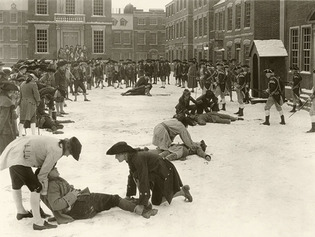
Manuscripts and Archives
A still from the Chronicles of America film “The Eve of the Revolution” depicts the aftermath of the Boston Massacre.
View full image
Artificial intelligence is not the first new technology to produce both change and mixed emotions in academia; the phenomenon goes back at least as far as the printing press. As motion pictures came into their own in the early twentieth century, many considered them mindless entertainment that could hinder (and certainly not help) the educational development of children. But in 1923, Yale embraced film as a tool for teaching, embarking on a planned series of 33 films to teach students from second grade through high school about American history.
The Chronicles of America Photoplays were based on a well-regarded 50-volume series of books that Yale University Press had published between 1918 and 1921. Also called the Chronicles of America, the books covered episodes and periods of American history and were aimed at a popular audience. Edited by Yale history professor Allen Johnson and overseen by a panel of his history department colleagues, the books were written with help from journalists and popular writers. As a 1925 Yale Alumni Weekly article explained it, “the editor rounded up a considerable number of these persons and mixed them with the historians in a sort of pepper-and-salt combination. Why not ask the best of the nation’s storytellers to assist in the telling of the matchless tale of their country?”
When the Press launched the film series, they used a similar approach. As a brochure for the films described it, “The script for each of the photoplays was prepared by a historical specialist. . . . These scripts were then put into continuity form by professional dramatists, a painstaking work.” George Pierce Baker, who founded Yale’s drama department, signed off on every script.
The Press also looked to the commercial film industry for directors, actors, and set and costume designers. The producers built elaborate sets and filmed on location, sometimes on the very battlefields being depicted. Architecture and clothing historians reviewed the sets and wardrobe for accuracy.
The creators saw in the medium of film an opportunity to “stimulate emotional responses” in students, as a teaching guide for the series put it. “The teacher may encourage an understanding of the loyalties, fortitudes, sacrifices, and tolerances of the great men and women throughout our history and the way in which they met and conquered their difficulties.”
Fifteen of the planned 33 films were completed over a two-year period at a cost of $1.25 million (about $23 million today). They mostly cover the colonial period, the Revolution, and westward expansion, along with one film, Dixie, that depicts the Civil War experience of a white Southern slaveholding family.
Although the series was conceived as a teaching tool for young people, the Press also contracted with the film company Pathé to distribute the films in public theaters. Press president George Parmly Day, Class of 1897, said the films could “do much for the betterment of the motion picture industry as well as for the cause of good citizenship.” An item in the New York Times said more specifically that the theatrical release was designed “to reach the foreign-born” at a time when the assimilation of immigrants was a source of anxiety among American elites.
From a twenty-first-century perspective, the films feel primitive and stilted, despite the production values. Silent and without music, they use frequent title cards for narration between pantomimed tableaus. Produced before the word “documentary” was coined for a fact-based narrative film, they borrow a visual language from fiction-based films, but since Yale was guaranteeing historical accuracy, there is little of the artistic license that would become the hallmark of Hollywood movies that are “based on a true story.”
A modern viewer will also notice an approach to history that, as in the Chronicles of America books, tends to gloss over uncomfortable aspects of the American story. The Civil War–related books and film hew to a Lost Cause and white supremacist narrative that was dominant in both North and South at the time. The volume The Sequel to Appomattox, for example, defends the work of the Ku Klux Klan on the grounds that “without the operations of the Klan the black districts would never have come again under white control.” There was no film made from that book, but the film Dixie depicts enslaved people as childlike and easily manipulated. Encounters with Native Americans in the films are told only from a European point of view.
Production was halted in 1925, apparently for financial reasons. Sales and rentals to schools were slower than hoped, perhaps because many schools didn’t have the equipment to show them. But the Press continued offering the films for sale and rental until 1960, when they shut down the program. They still had not recovered the production costs.
 loading
loading